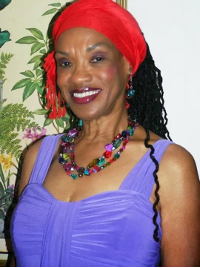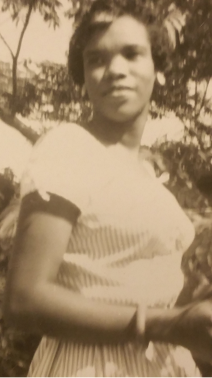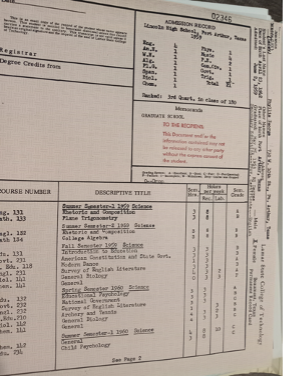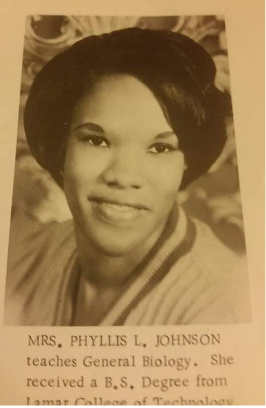Ms. Phyllis Lacey Baker
B.S. in Education with a specialization in Science, Class of 1963
Interviewed by Vidisha Barua Worley on 03/15/2023


‘I graduated from Lincoln High School in 1959. It was my parents’ choice because the newly integrated Lamar University made it so convenient and much less expensive that I would go as a freshman beginning in the Summer of 1959. At that time, segregation was very much a product of my experiences. I lived on the west side of Port Arthur where all the Black people lived at that particular time. The only association I had with people of other ethnic groups was through my father’s business. He owned the appliance and hardware store. To have actual social engagement with people who were not of the same ethnic group as me was foreign to me. I had had no other standards to compare myself to other than the standards set by the high school that I attended. Lamar was the gateway to my stepping into the world that was not small, confined private safe space that I had lived in up to that time. I was young. I was 17. I am looking at my transcript right now. I took plane trigonometry, rhetoric and composition. I graduated in 1963. I would have graduated a year earlier, but my education was interrupted by a pregnancy.’
‘Life as a student was very much segregated. In other words, Black students collaborated with each other and we spent a lot of time upstairs in what was like a recreational space. There were very few instances where people of either race crossed socially to interact with people of the other race. Very seldom.’
‘My first day on the campus, I almost have a visual memory of it. Walking around, looking for the colored people. I saw some girls sitting under a tree who I didn’t know because I was from Port Arthur. I didn’t know a lot of people from Beaumont. In 1959, you did not have much social connection with anybody who did not go to the school you went to and lived in the neighborhood you lived in. There were no opportunities for us to have much interaction. So, that was the main thing that stood out at Lamar as far as social interaction is concerned. One girl in particular, I don’t remember her name. She was of Jewish persuasion. She came to me and made friends with me. I think her name was Darius. I remember telling my mother. My mother explained to me that maybe the reason why Darius has been so outgoing and friendly and inviting to me because as a Jewish girl, she had faced persecution also. My mother told me that. That gave me some knowledge and something to think about.
‘As far as academically it was challenging because the students who went to school in the west side of Port Arthur, we didn’t get anything new. We didn’t get new textbooks. As far as labs were concerned, we didn’t have microscopes or anything. Whatever we had had been passed on to us from Thomas Jefferson High School, the White school. But we had teachers who were dedicated and passionate. They had substandard education too. Because they had to go to designated school for people of color. So, for me to be drawn into a situation where I am competing against kids who had a better background, the only thing I had going for me was I had people who cared about me, knew me by name, wanted me to be the best.
‘One of my teachers in my composition class, Mr. Copeland, after I had done my very first assignment, and I did make an A in the class, he told me that he really enjoyed reading my composition. He said, you can make an A in this class if you work hard. And now I am 81 years old, but I will never forget how that 17-year-old little girl felt when this white man, who intuitively knew that he had to say something to me to encourage me not to give up. And who is to say that did not set the path for me. All the other students in the class were white. My father was the principal of an elementary school. He was an educator himself. So, he made me take Math and English in the summer by themselves so that I could have a better chance of success with these difficult classes.’

 .
.

‘By the Fall of 1960, I already had my confidence boosted by making very good grades. I do appreciate my parents’ wisdom for sending me to school.’
‘The student center had a room upstairs at the very top floor that looked out on the campus, many of the Black classmates would be there talking about their frustration. They did not have the family support I had. They were not fortunate enough to have a professor who came to them and encouraged them. They would cut class. A lot of my classmates were not as fortunate as me. They were overwhelmed. ‘I had another professor Dr. Hayes, the department chair of Science. He was a heavy-set white guy. We had the big lecture hall with rows and rows of seats. He taught us genetics and, in his lectures, he would say, negras when referring to the black people in the genetic map. He chooses to repeatedly use the word. That was a terrible experience. I had the white kids give me a funny look. I had my family support and the personal constitution and I didn’t let that get in my way. I had what it took to persevere. It was the first time for the white kids too. They were also confused. They had to have a lot of courage just to make friends with us. We made it through.’
‘I went straight from college into a job at a high school in Port Arthur, because Lamar helped with the placement. The School of Education did. I taught for eight years before integration came in the 60s. In the schools in Beaumont, the white teachers had to teach in the Black schools and the Black teachers had to teach in the white schools. We had no choice. It was forced. So, I wound up at South Park High School teaching AP Biology. I was not trained to teach AP Biology. If it weren’t for those kids, I would not have made it. The students were kind to me. I stayed one year there and then moved to Virginia. I spent 13 years in Virginia and 17 years in Los Angeles. I have taught in about five different school districts across the country. Nobody knew what they were doing back then. They just threw us into a cauldron and I happen to be a success story.’

